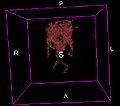Difference between revisions of "2010 Winter Project Week Tractography using DTI Atlasing"
(Created page with '__NOTOC__ <gallery> Image:PW-SLC2010.png|Projects List Image:Anuja_scatter1.png|Kernel regression along the fiber tract, also showing the sc…') |
|||
| (18 intermediate revisions by 2 users not shown) | |||
| Line 1: | Line 1: | ||
__NOTOC__ | __NOTOC__ | ||
<gallery> | <gallery> | ||
| − | Image:PW-SLC2010.png|[[2010_Winter_Project_Week#Projects| | + | Image:PW-SLC2010.png|[[2010_Winter_Project_Week#Projects|Project List]] |
| − | Image: | + | Image:fid_seed.jpg| |
| − | Image: | + | Image:Fiducial_seeding_coronal.jpg| |
| + | Image:Stochastic_tractography.jpg| | ||
</gallery> | </gallery> | ||
==Key Investigators== | ==Key Investigators== | ||
| − | * Utah: | + | * Utah: Gopalkrishna Veni, Ross Whitaker, Sarang Joshi |
<div style="margin: 20px;"> | <div style="margin: 20px;"> | ||
| Line 14: | Line 15: | ||
<h3>Objective</h3> | <h3>Objective</h3> | ||
| − | + | To study the effect of drugs on teenagers in the age group of 12-30. | |
| Line 24: | Line 25: | ||
<h3>Approach, Plan</h3> | <h3>Approach, Plan</h3> | ||
| − | + | Initially, the DWI data is preprocessed to address Eddy current correction and EPI distortion correction. Next, DTI Atlas building is performed using Casey’s DTI analysis pipeline* to bring all the DTI images into a common co-ordinate system and then fiber tract analysis is performed to compare the differences in specific fiber tracts. Our aim for the project week is to explore various DTI analysis tools developed by NAMIC to perform tractography. | |
| − | |||
| − | |||
| − | |||
| − | |||
| − | Our | ||
</div> | </div> | ||
| Line 37: | Line 33: | ||
<h3>Progress</h3> | <h3>Progress</h3> | ||
| − | + | During this week, two tractographic modules using Fiducial seeding and Python stochastic tractography have been explored using our dataset. | |
| − | + | I am still working on the problem related to the registration of T2 weighted image with the DTI baseline image. | |
</div> | </div> | ||
</div> | </div> | ||
| Line 45: | Line 41: | ||
==References== | ==References== | ||
| − | *Casey B. Goodlett, P. Thomas Fletcher, John H. Gilmore, Guido Gerig. Group Analysis of DTI Fiber Tract Statistics with Application to Neurodevelopment. NeuroImage 45 (1) Supp. 1, 2009. p. S133-S142 | + | *Casey B. Goodlett, P. Thomas Fletcher, John H. Gilmore, Guido Gerig. Group Analysis of DTI Fiber Tract Statistics with Application to Neurodevelopment. NeuroImage 45 (1) Supp. 1, 2009. p. S133-S142. |
</div> | </div> | ||
Latest revision as of 17:29, 8 January 2010
Home < 2010 Winter Project Week Tractography using DTI AtlasingKey Investigators
- Utah: Gopalkrishna Veni, Ross Whitaker, Sarang Joshi
Objective
To study the effect of drugs on teenagers in the age group of 12-30.
Approach, Plan
Initially, the DWI data is preprocessed to address Eddy current correction and EPI distortion correction. Next, DTI Atlas building is performed using Casey’s DTI analysis pipeline* to bring all the DTI images into a common co-ordinate system and then fiber tract analysis is performed to compare the differences in specific fiber tracts. Our aim for the project week is to explore various DTI analysis tools developed by NAMIC to perform tractography.
Progress
During this week, two tractographic modules using Fiducial seeding and Python stochastic tractography have been explored using our dataset. I am still working on the problem related to the registration of T2 weighted image with the DTI baseline image.
References
- Casey B. Goodlett, P. Thomas Fletcher, John H. Gilmore, Guido Gerig. Group Analysis of DTI Fiber Tract Statistics with Application to Neurodevelopment. NeuroImage 45 (1) Supp. 1, 2009. p. S133-S142.



